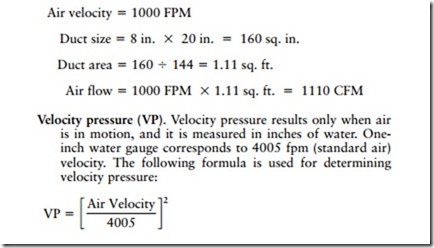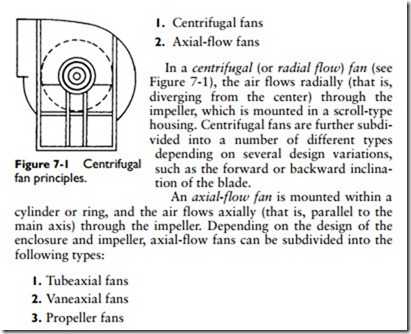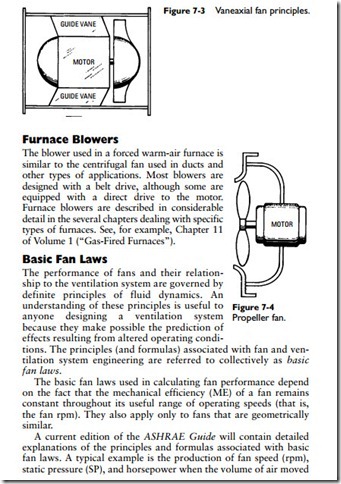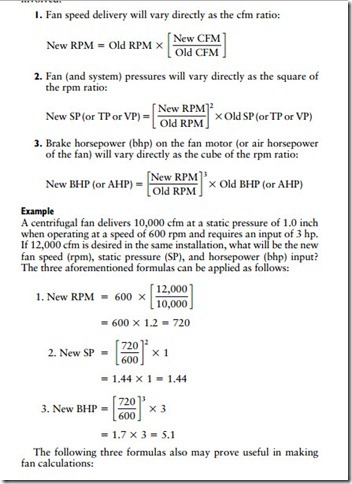Both ventilation and air circulation utilize fans to move the air. Ventilation is concerned with the moving of a volume of air from one space to another. It does not involve the weight of air but the volume of air in cubic feet moved per minute (cfm). The circulation of air, on the other hand, is concerned with the velocity at which air moves around a confined space and is expressed in feet per minute (fpm).
This chapter is concerned primarily with introducing the reader to the problems of fan selection and operation. Several sections of this chapter provide detailed instructions for fan sizing. Because the selection of a fan and the design of a duct system are mutually dependent, Chapter 7 of Volume 2 (“Ducts and Duct Systems”) should also be consulted.
Codes and Standards
Always consult local codes and standards before designing or attempting to install a fan system. Other sources of information on codes and standards pertaining to fans and fan systems are as follows:
1. The Air Moving and Conditioning Association (AMCA).
2. The National Association of Fan Manufacturers (NAFM).
3. The American Society of Heating, Refrigerating and Air- Conditioning Engineers (ASHRAE).
4. Home Ventilation Institute (HVI).
Definitions
A number of terms and definitions largely related to fan selection and operation should be examined and learned for a clearer understanding of the materials in this chapter. Most of the terms and definitions contained in this section are provided by the Air Moving and Conditioning Association.
Air horsepower (AHP). The work done in moving a given volume (or weight) of air at a given speed. Air horsepower is also referred to as the Morse power output of a fan.
Area (A). The square feet of any plane surface or cross section.
Area of duct. The product of the height and width of the duct multiplied by the air velocity equals the cubic feet of air per minute flowing through the duct.
Brake horsepower (BHP). The work done by an electric motor in driving the fan, measured as horsepower delivered to the fan shaft. In belt-drive units, the total workload is equal to the workload of the electric motor plus the drive losses from belts and pulleys. The brake horsepower is always a higher number than air horsepower (AHP). Brake horse- power is also referred to as the horsepower input of the fan.
Cubic feet per minute (cfm). The physical volume of air moved by a fan per minute expressed as fan outlet conditions.
Density. The actual weight of air in pounds per cubic foot (0.075 at 70°F and 29.92 inches barometric pressure).
Fan inlet area. The inside area of the inlet collar.
Fan outlet area. The inside area of the fan outlet.
Mechanical efficiency (ME). A decimal number or a percentage representing the ratio of air horsepower (AHP) to brake horsepower (BHP) of a fan. It will always be less than
1.000 or 100 percent and may be expressed as follows:
Outlet velocity (OV). The outlet velocity of a fan measured in feet per minute.
Revolutions per minute (RPM). The speed at which a fan or motor turns.
Standard air. Air at 70°F and 29.92 inches barometric pressure weighing 0.075 lbs per cubic foot.
Static efficiency (SE). The static efficiency of a fan is the mechanical efficiency multiplied by the ratio of static pressure to the total pressure.
Static pressure (SP). The static pressure of a fan is the total pressure diminished by the fan velocity pressure. It is measured in inches of water (see velocity pressure).
Tip speed (TS). Also referred to as the peripheral velocity of wheel. It is determined by multiplying the circumference of the wheel by the rpm.
The tip speed should not exceed 3300 rpm if a quiet operation is to be obtained.
Total pressure (TP). Any fan produces a total pressure (TP), which is the sum of the static pressure (SP) and the velocity pressure (VP). Total pressure represents the rise of pressure from fan inlet to fan outlet.
Velocity. The speed in feet per minute (fpm) at which air is moving at any location (for example, through a duct, inlet damper, outlet damper, or fan discharge point). When the performance data for air-handling equipment are given in feet per minute (fpm), conversion to cubic feet per minute can be made by multiplying the fpm by the duct area:
The various mechanical devices used to move the air in heating, ventilating, and air-conditioning installations are known as fans, blowers, exhausts, or propellers.
Every fan is equipped with an impeller, which forces (impels) the airflow. The manner in which air flows through the impeller pro- vides the basis for the following two general classifications of fans:
A tubeaxial fan consists of an axial-flow wheel within a cylinder (see Figure 7-2). These fans are available in a number of different types depending on the design and construction of the impeller blades.
A vaneaxial fan also consists of an axial-flow wheel but differs from a tubeaxial fan in that it uses a set of vanes to guide the air- flow and increase efficiency (see Figure 7-3).
A propeller fan consists of a propeller or disc wheel within a ring casing or plate. These fans are by far the simplest in construction and operate best against low resistance (see Figure 7-4).
by the fan is varied. The following three principles and formulas are involved:







